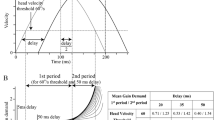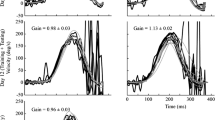Abstract
Latencies of normal and adapted feline vestibulo-ocular reflex (VOR) were studied in five cats by applying ± 20°/s horizontal head velocity steps (4000°/s2 acceleration) and measuring the elicited horizontal or vertical reflex eye responses. Normal VOR latency was 13.0 ms ± 1.9 SD. Short-term adaptation was then accomplished by using 2 h of paired horizontal sinusoidal vestibular stimulation and phase-synchronized vertical optokinetic stimulation (cross-axis adaptation). For long-term adaptation, cats wore ×0.25 or ×2.2 magnifying lenses for 4 days. The cats were passively rotated for 2 h/day and allowed to walk freely in the laboratory or their cages for the remainder of the time. The latency of the early (primary) adaptive response was 15.2ms±5.2 SD for crossaxis adaptation and 12.5 ms±3.9 SD for lens adaptation. This short-latency response appeared within 30 min after beginning the adaptation procedure and diminished in magnitude overnight. A late (secondary) adaptive response with latency of 76.8 ms±7.0 SD for cross-axis adaptation and 68.1 ms±8.8 SD for lens adaptation appeared after approximately 2 h of adaptation. It had a more gradual increase in magnitude than the primary response and did not diminish in magnitude overnight. These data suggest that brainstem VOR pathways are a site of learning for adaptive VOR modification, since the primary latency is short and has a similar latency to that of the normal VOR.
Similar content being viewed by others
References
Baker J, Goldberg J, Peterson B (1985) Spatial and temporal response properties of the vestibulocollic reflex in decerebrate cats. J Neurophysiol 54:735–756
Baker R, Weiser M, McElligott J (1988) Adaptive gain control of the vestibulo-ocular reflex in goldfish. I. Hemi-cerebellectomy. Soc Neurosci Abstr 14:72.6
Baker R, Pastor E, Weiser M, McElligott J (1989) The latency and gain of the horizontal vestibulo-ocular reflex in goldfishes determined by vestibular and position velocity steps during learning and memory. Soc Neurosci Abstr 15:324.9
Blanks R, Curthoys I, Markham C (1972) Planar relationships of semicircular canals in the cat. Am J Physiol 223:55–62
Bond H, Ho P (1970) Solid miniature silver-silver chloride electrodes for chronic implantation. Electroencephalogr Clin Neurophysiol 29:206–208
Cohen B, Suzuki J, Bender M (1964) Eye movements from semicircular nerve stimulation in the cat. Ann Otol Rhinol Laryngol 75:153–165
Collewijn H, Martins A, Steinman R (1983) Compensatory eye movements during active and passive head movements: fast adaptation to changes in visual magnification. J Physiol (Lond) 340:259–286
Demer J, Robinson D (1982) Effects of reversible lesions and stimulation of olivocerebellar system on vestibuloocular reflex plasticity. J Neurophysiol 47:1084–1107
Dufosse M, Ito M, Miyashita Y (1978) Diminution and reversal of eye movements induced by local stimulation of rabbit cerebellar flocculus after partial destruction of the inferior olive. Exp Brain Res 33:139–141
Fetter M, Zee DS, Proctor LR (1988) Effect of lack of vision and of occipital lobectomy upon recovery from unilateral labyrinthectomy in rhesus monkey. J Neurophysiol 59:394–407
Fuchs A, Kimm J (1975) Unit activity in vestibular nucleus of the alert monkey during horizontal angular acceleration and eye movement. J Neurophysiol 38:1140–1161
Ghelarducci B, Ito M, Yagi N (1975) Impulse discharges from flocculus Purkinje cells of alert rabbits during visual stimulation combined with horizontal head rotation. Brain Res 87:66–72
Gonshor A, Melvill-Jones G (1976a) Extreme vestibulooccular adaptation induced by prolonged optical reversal of vision. J Physiol (Lond) 256:381–414
Gonshor A, Melvill-Jones G (1976b) Short-term adaptive changes in the human vestibulo-ocular reflex arc. J Physiol (Lond) 256:361–379
Haddad G, Friendlich A, Robinson D (1980) The effect of lesions of the dorsal cap of the inferior olive and the vestibulo-ocular and optokinetic systems of the cat. Brain Res 185:265–275
Harrison R, Baker J, Isu N, Wickland C, Peterson B (1986) Dynamics of adaptive change in vestibulo-ocular reflex direction. I. Rotations in the horizontal plane. Brain Res 371:162–165
Houk J, Singh S, Fisher C, Barto A (1991) An adaptive sensorimotor network inspired by the anatomy and physiology of the cerebellum. In: Miller W, Sutton R, Werbos P (eds) Neural networks for control. MIT, Cambridge Mass
Ito M (1982) Cerebellar control of the vestibulo-ocular reflex around the flocculus hypothesis. Annu Rev Neurosci 5:275–296
Ito M (1984) The cerebellum and neural control. Raven, New York
Ito M, Miyashita (1975) The effects of chronic destruction of inferior olive upon visual modification of the horizontal vestibuloocular reflex of rabbits. Proc Jpn Acad 51:716–760
Ito M, Shiida T, Yagi N, Yamamoto M (1974a) Visual influence on rabbit horizontal vestibulo-ocular reflex presumably effected via the cerebellar flocculus. Brain Res 65:170–174
Ito M, Shiida T, Yagi N, Yamamoto M (1974b) The cerebellar modification of rabbit's horizontal vestibulo-ocular reflex induced by sustained head rotation combined with visual stimulation. Proc Jpn Acad 50:85–89
Judge S, Richmond B, Chu F (1980) Implantation of magnetic search coils for measurement of eye position: an improved method. Vision Res 20:535–538
Khater T, Peterson B, Baker J (1990) Dynamics of adaptive change in human vestibulo-ocular reflex direction. J Vestib Res 1:23–39
Lisberger S (1984) The latency of pathways containing the site of motor learning in the monkey vestibulo-ocular reflex. Science 225:74–76
Lisberger S (1988a) The neural basis for motor learning in the vestibulo-ocular reflex in monkeys. Trends Neurosci 11:147–152
Lisberger S (1988b) The neural basis for learning of simple motor skills. Science 242:728–735
Lisberger S, Pavelko T (1988) Brain stem neurons in modified pathways for motor learning in the primate vestibulo-ocular reflex. Science 242:771–773
Lisberger S, Miles F, Optican L, Eighmy B (1981) Optokinetic response in monkey: underlying mechanisms and their sensitivity to long-term adaptive changes in VOR. J Neurophysiol 45:869–890
Lisberger S, Miles F, Zee D (1984) Signals used to compute errors in monkey vestibulo-ocular reflex: possible role of flocculus. J Neurophysiol 52:1140–1153
Michnovicz J, Bennett M (1987) Effects of rapid cerebellectomy on adaptive gain control of the vestibulo-ocular reflex in alert goldfish. Exp Brain Res 66:287–294
Miles F, Braitman D (1980) Long-term adaptive changes in primate VOR. II. Electrophysiological observations on semicircular canal primary afferents. J Neurophysiol 43:1426–1436
Miles F, Eighmy B (1980) Long-term adaptive changes in primate vestibuloocular reflex. I. Behavioral observations. J Neurophysiol 43:1406–1425
Miles F, Fuller J (1974) Adaptive plasticity in the vestibulo-ocular responses of the rhesus monkey. Brain Res 80:512–516
Miles F, Lisberger S (1981) Plasticity in the vestibulo-ocular reflex: a new hypothesis. Annu Rev Neurosci 4:273–299
Miles F, Braitman D, Dow B (1980a) Long-term adaptive changes in primate VOR. IV. Electrophysiological observations in flocculus of adapted monkeys. J Neurophysiol 43:1477–1493
Miles F, Fuller J, Braitman J, Dow B (1980b) Long-term adaptive changes in primate vestibuloocular reflex. III. Electrophysiological observations in flocculus of normal monkeys. J Neurophysiol 43:1437–1476
Peterson B, Baker J, Houk J (1991) A model of adaptive control of vestibuloocular reflex based on properties of cross-axis adaptation. Ann NY Acad Sci 627:319–337
Robinson D (1964) The mechanics of human saccadic eye movement. J Physiol (Lond) 175:245–264
Robinson D (1965) The mechanics of human smooth pursuit eye movement. J Physiol (Lond) 180:569–591
Robinson D (1976) Adaptive gain control of the vestibuloocular reflex by the cerebellum. J Neurophysiol 39:954–969
Sato Y, Kawasaki T (1987) Target neurons of floccular caudal zone inhibition in y-group nucleus of vestibular nuclear complex. J Neurophysiol 57:460–480
Sato Y, Kawasaki T (1990) Operational unit responsible for planespecific control of eye movement by cerebellar flocculus in cat J Neurophysiol 64:551–564
Schairer J, Bennet M (1981) Cerebellectomy in goldfish prevents adaptive gain control of the VOR without affecting the optokinetic system. In: Gualtierotti T (ed) Vestibular function and morphology. Springer, Berlin Heidelberg New York, pp 463–477
Schultheis L, Robinson D (1981) Directional plasticity of the vestibulo-ocular reflex in the cat. Ann NY Acad Sci 374:504–512
Snyder L, King W (1988) Vertical vestibuloocular reflex in cat: asymmetry and adaptation. J Neurophysiol 59:279–298
Snyder L, King W (1989) Modulation of gaze velocity purkinje (GVP) cells during vestibulo-ocular reflex (VOR) with near and far visual targets. Soc Neurosci Abstr 324.8
Snyder L, King W (1991) The response of gaze velocity purkinje (GVP) cells to sustained velocity (1-2s) does not predict their response immediately after a rapid head acceleration. Soc Neurosci Abstr 337.9
Watanabe E (1984) Neuronal events correlated with long term adaptation of the horizontal vestibulo-ocular reflex in the primate flocculus. Brain Res 297:169–174
Weiser M, Pastor A, Baker R (1989) Monocular adaptive gain control of the vestibulo-ocular reflex in the goldfish. Soc Neurosci Abstr 324.10
Author information
Authors and Affiliations
Rights and permissions
About this article
Cite this article
Khater, T.T., Quinn, K.J., Pena, J. et al. The latency of the cat vestibulo-ocular reflex before and after short- and long-term adaptation. Exp Brain Res 94, 16–32 (1993). https://doi.org/10.1007/BF00230467
Received:
Accepted:
Issue Date:
DOI: https://doi.org/10.1007/BF00230467




